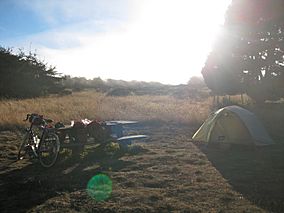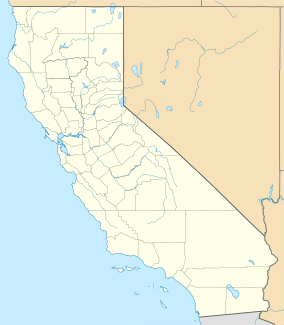Manchester State Park (California) facts for kids
Quick facts for kids Manchester State Park |
|
|---|---|

Campsite at Manchester State Park, September 2010
|
|
| Location | Mendocino County, California, USA |
| Nearest city | Manchester, California |
| Area | 5,272 acres (21.34 km2) |
| Established | 1955 |
| Governing body | California Department of Parks and Recreation |
Manchester State Park, also known as Manchester State Beach, is a fun state park in California, USA. It has about 3.4 miles (5.5 km) of protected beach along the Pacific Ocean in Northern California. You can find it about 7 miles (11 km) north of Point Arena, right off Highway 1.
This park is special because it has sandy dunes, flat grassy areas, and five miles of soft, sandy beach. It's a great spot for fishing for steelhead and salmon in its two streams, Brush Creek and Alder Creek. You'll also see lots of cool driftwood washed up on the curved coastline. This large park, covering 5,272 acres (2,134 ha), became a California state park in 1955. It's named after the nearby town of Manchester, California.
Besides the amazing ocean views, Manchester State Beach has open grazing lands where you might spot flocks of sheep and herds of cattle. The park is also home to many beautiful wildflowers like Blue Irises, baby blue eyes, lupines, poppies, and sea pinks. Did you know the famous San Andreas Fault actually runs into the ocean waters right off the park's coast?
Contents
Ocean Wildlife and Migration
From October to April, you can often see amazing Humpback whales and Gray whales swimming offshore. They are on their yearly migration journey! If you're an experienced diver, you can explore the kelp forests and other marine life in the protected waters near Point Arena. It's like an underwater adventure!
Camping at the Park
If you want to camp at Manchester State Park, spots are given out first come, first served. However, you need to make reservations ahead of time. Group campgrounds are available until November 16th.
Protecting Our Oceans
The Point Arena State Marine Reserve & Point Arena State Marine Conservation Area are special underwater areas right off Point Arena. There are also the Sea Lion Cove State Marine Conservation Area and Saunders Reef State Marine Conservation Area to the south. Think of these as underwater parks! They help protect ocean wildlife and the amazing sea environments, keeping them safe for future generations.
Park History
Long ago, before Europeans arrived, the land that is now Manchester State Park belonged to the Pomo people. They were the native people of this area. Over time, the Pomo people gradually became part of the wider society.
Manchester State Park was once considered for closure in 2012, along with many other California state parks. This was part of a plan to save money. Luckily, these closures were avoided by reducing park hours and maintenance across the state.
Weather at the Park
The weather at Manchester State Park is usually mild. Temperatures range from a high of about 72 degrees Fahrenheit (22°C) to a low of 50 degrees Fahrenheit (10°C). The park gets a lot of rain from September to May. During the summer months, it's common to have fog in the evenings. Strong winds blow year-round, so it's a good idea to bring warm clothes, even in summer!
Exploring Manchester State Park
One popular activity is the hike to Alder Creek. It's a five-mile (8 km) round trip that takes you along the beach and through the woods. When you reach Alder Creek, you might see many waterfowl and salmon swimming upstream, depending on the time of year. Because of the strong winds, it's smart to check the wind report before you plan your trip.
As you explore the coastline, you'll notice huge piles of driftwood. Hikers often find themselves climbing over these natural sculptures scattered across the beach. Near the southern end of the park, you can take tours of the historic Point Arena Lighthouse, which was built way back in 1870. The beach also has an upland area with loop trails. These trails lead you past ponds, through dark sand, and up and around bluffs and dunes.
You can find the main trailhead seven miles (11 km) north of Point Arena on Kinney Road. The park has signs to help direct you to the trails. As you walk around, you'll see unique wind shelters built by other beach-goers using driftwood. There's also a connector trail to Alder Creek where you can explore an old, abandoned beach house about half a mile (0.8 km) into the trail.



